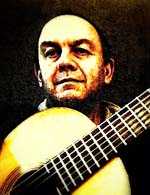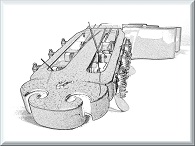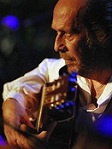Welcome to one of the most active flamenco sites on the Internet. Guests can read most posts but if you want to participate click here to register.
This site is dedicated to the memory of Paco de Lucía, Ron Mitchell, Guy Williams, Linda Elvira, Philip John Lee, Craig Eros, Ben Woods, David Serva and Tom Blackshear who went ahead of us.
We receive 12,200 visitors a month from 200 countries and 1.7 million page impressions a year. To advertise on this site please contact us.
|

|
|
RE: Flamenco and Classical guitar duet
|
You are logged in as Guest
|
|
Users viewing this topic: none
|
|
Login  | |
|

   
Richard Jernigan
Posts: 3430
Joined: Jan. 20 2004
From: Austin, Texas USA

|
 RE: Flamenco and Classical guitar duet (in reply to Ricardo) RE: Flamenco and Classical guitar duet (in reply to Ricardo)
|
|
|
quote:
ORIGINAL: Ricardo
using the (rather derogatory) adjective to describe music that is not in anyway at all "jazz" related.
Ricardo
Ricardo I think I can understand a little of how you feel about the implied putdowns. When I was a kid I played in the Washington Summer Symphony, an award winning high school concert band, in a jazz group, a mambo band and my own fairly eclectic band, that played for dances as well as for just listening.
Each group contained people who put down most of the others. Jazz friends would ask, "Why do you sit around all evening and just read notes off the page?" Symphony friends would ask, "Why do you hang around with those guys that play out of tune all the time?" Mambo friends would ask, "Where's the clave, man? That stuff just doesn't move…"
Some of the best Balinese musicians I have known have expressed puzzlement at European classical music--and Balinese gamelan is some of the most complex and sophisticated music on the planet.
Ever since I took up the guitar I have played some classical and some traditional flamenco. We all know how that has been, for the last 75 years at least.
I love it all. So "reminding me of jazz" is no putdown coming from me.
But isn't it going just a bit far to say the modern style of flamenco guitar solo isn't at all jazz related? Didn't Paco himself say that playing with McLaughlin and DiMeola really challenged him to learn more and to open up his harmonies? To me, this is a relation to jazz, even if Paco's music is not actually jazz.
This may sound like just a quibble, but as a kid I was bemused by the claims that musics that clearly influenced one another were actually totally separate and unrelated.
RNJ
|
|
|
|
REPORT THIS POST AS INAPPROPRIATE |
Date Sep. 7 2014 20:51:35
 |
|

   
BarkellWH
Posts: 3458
Joined: Jul. 12 2009
From: Washington, DC

|
 RE: Flamenco and Classical guitar duet (in reply to Richard Jernigan) RE: Flamenco and Classical guitar duet (in reply to Richard Jernigan)
|
|
|
quote:
Some of the best Balinese musicians I have known have expressed puzzlement at European classical music--and Balinese gamelan is some of the most complex and sophisticated music on the planet.
There are three main streams of gamelan music in Indonesia--Sundanese, Javanese, and Balinese--and all three are very complex and sophisticated. You no doubt are aware that the gamelan is native to Indonesia (primarily Java). It reached its apex on Java during the Majapahit Empire, a Hindu empire that lasted until Islam began taking over in the 14th century and gradually forced the Hindu Majapahits further and further east on Java, until the remains of the Empire ended up on Bali, where it continues today. Yet, interestingly, the three gamelan styles--Sundanese, Javanese, and Balinese--continue in their respective regions today.
Although the gamelan originated on Java, one of the most important components of the gamelan (in Sunda, Java, and Bali), the Sinden, (always a woman who sings beautifully and hauntingly). has been heavily influenced by Indian music. While I was living in Jakarta and assigned to the U.S. Embassy, I became good friends with an ethno-musicologist who was based in Bali and had lived there for many years. He had written many monographs on both the gamelan and, specifically, on the development of the gong, which is another Javanese innovation. I had a gong made in Bogor, a center of gong-manufacturing located an hour out of Jakarta, and I still keep it in our home, where it is an interesting artifact used to call guests to dinner.
Interestingly, Western music has not made much inroad into the gamelan, but the reverse is certainly true: The gamelan has influenced Western music. The following is extracted from "American Mavericks," in Association with the San Francisco Symphony.
"Canadian composer Colin McPhee was not the first Westerner to have his life changed by Asian music. The French composer Claude Debussy, too, had heard a Javanese gamelan at the 1889 Paris World Exhibition, and tried to imitate its harmonies. But McPhee went further - much further - to Bali itself. He had spent the 1920s in New York City, writing highly rhythmic music of repeating patterns under the spell of Igor Stravinsky. By the late 1920s, according to his biographer Carol Oja, he was at a compositional impasse, disillusioned with writing esoteric music for small audiences. "Quite by accident," as McPhee put it, he heard some recordings of Balinese music released in 1928 on the Odeon label. [Balinese gamelan recording fades in beneath the following] "The clear, metallic sounds," he later wrote, "were like the stirring of a thousand bells, delicate, confused, with a sensuous charm, a mystery that was quite overpowering.... I returned the records, but I could not forget them. I knew little about the music of the East. I still believed that an artist must keep his mind on his own immediate world. But... after I had read... the quite fabulous accounts of these ancient and ceremonial orchestras, my imagination took fire, and... I determined to make a trip to the East to see them for myself."
McPhee and his wife, the anthropologist Jane Belo, visited Bali for six months in 1931, and returned the follow year for a longer visit. They found a spot high in the hills near the little village of Sayan, perched on a mountain ridge, and built a house in Balinese style, made of bamboo and a thatched roof. There were no stores around, just an open market every other day, nor was there plumbing or electricity. McPhee interviewed Balinese musicians and eventually borrowed gamelan instruments and started his own gamelan - an orchestra of metallophones and gongs. The experience changed him forever. Returning to Paris when his visa expired, he "found himself 'restless' at concerts and claimed that 'the programs of new music that I once delighted in now seemed suddenly dull and intellectual.' He longed for the magic of the 'sunny music" of Bali."
In 1936 McPhee wrote what would become and remain his most famous composition, Tabuh-Tabuhan. Half composition, half transcription, this was the first attempt to reproduce the patterns of Balinese music using a conventional European orchestra. From the very opening, it uses a simple four-note row in different permutations and at different rhythmic levels at once, just like much Balinese music. The second movement begins with a flute melody that is McPhee's own, but written in an exotic scale and sounding like a Balinese suling flute. The third movement is closest of all to Balinese music, basically an orchestral transcription of one of the Odeon recordings McPhee had found. However, even in this he was following Balinese practice, because composers of traditional Balinese music start with traditional melodic formulas and place them in new combinations. As McPhee himself wrote, "In Bali music is not composed but rearranged."
Bill
_____________________________
And the end of the fight is a tombstone white,
With the name of the late deceased,
And the epitaph drear, "A fool lies here,
Who tried to hustle the East."
--Rudyard Kipling
|
|
|
|
REPORT THIS POST AS INAPPROPRIATE |
Date Sep. 8 2014 0:05:13
 |
|

   
BarkellWH
Posts: 3458
Joined: Jul. 12 2009
From: Washington, DC

|
 RE: Flamenco and Classical guitar duet (in reply to Paul Magnussen) RE: Flamenco and Classical guitar duet (in reply to Paul Magnussen)
|
|
|
quote:
Can you recommend any particular recordings? Also, do you happen to know of any books or articles on its theory and/or structure that might be intelligible to a Westerner?
Paul,
A very good source for information about the gamelan is the American Gamelan Institute's website. They have an online library; a catalog of scores, notation, and monographs; a store where one can purchase books and CDs; and one can subscribe to their Journal "Balungan," which is in English. The material they offer (including CDs) covers Javanese gamelan (particularly that of Jogjakarta, the Central Javanese court which still has a Sultan), as well as Sundanese (West Java), and Balinese gamelan.
Cheers,
Bill
_____________________________
And the end of the fight is a tombstone white,
With the name of the late deceased,
And the epitaph drear, "A fool lies here,
Who tried to hustle the East."
--Rudyard Kipling
|
|
|
|
REPORT THIS POST AS INAPPROPRIATE |
Date Sep. 8 2014 16:22:22
 |
|

   
Richard Jernigan
Posts: 3430
Joined: Jan. 20 2004
From: Austin, Texas USA

|
 RE: Flamenco and Classical guitar duet (in reply to BarkellWH) RE: Flamenco and Classical guitar duet (in reply to BarkellWH)
|
|
|
quote:
ORIGINAL: BarkellWH
There are three main streams of gamelan music in Indonesia--Sundanese, Javanese, and Balinese--and all three are very complex and sophisticated. You no doubt are aware that the gamelan is native to Indonesia (primarily Java). It reached its apex on Java during the Majapahit Empire, a Hindu empire that lasted until Islam began taking over in the 14th century and gradually forced the Hindu Majapahits further and further east on Java, until the remains of the Empire ended up on Bali, where it continues today. Yet, interestingly, the three gamelan styles--Sundanese, Javanese, and Balinese--continue in their respective regions today.
As McPhee himself wrote, "In Bali music is not composed but rearranged."
Bill
The borderline between composition and rearrangement is a bit fuzzy. After talking with the guru of the Bangli gamelan about the development of the 10-minute piece he was teaching the orchestra, I would say that particular process was well on the composition side of the line.
But the newer gong kebyar style has come to the fore in Bali since McPhee's day.
Despite my surprisingly advanced age, I have no experience of Javanese gamelan at its apex in the 14th century. But on Java I have heard the ancient gamelan at the Sultan's palace in Solo, the accompaniment to wayang orang in the same city, one of the gamelans at the Sultan's palace in Yogyakarta, accompaniment to wayang kulit at the Yogyakarta palace, accompaniment to the Sea Goddess dances at Parang Tritis, and the accompaniment to the Ramayana dance performance at the large performance center near the highway intersection where the road goes up to Tretes in East Java.
It is a matter of personal taste, of course, but I find contemporary Balinese gamelan more interesting. It is certainly more lively and complex. One of the intriguing features of Indonesian classical dance is the rapid succession of gestures, or what might be called or "poses". These are specific configurations of all parts of the body, including the eyes, which are taught and practiced from childhood, when a dancer's training begins.
An example from a famous Balinese dancer:

Sorry you can't see her legs and bare feet. They are important components. The feet are particularly expressive.
The poses sometimes follow one another in rapid succession, as quickly as 240 beats/minute, telling a story. It makes for an interesting challenge in action photography. The music is tightly integrated with the dance, each gesture gets at least one beat, often several. Sequences of gestures often get extended musical phrases.
A fairly serious tourist performance can last an hour and a half. A performance for a Balinese audience can go on almost all night.
Dance performances of the classic stories vary considerably from one troupe to another, and evolve over time from a given troupe, though the stories are recognizable even to a foreigner like me. The music must be re-fashioned to fit the dance performances.
Besides dance accompaniment, gamelan in Bali enjoys a lively concert scene. Every town and village of any size has its gamelan, composed of amateurs, except for the guru, whose salary is paid from members' dues. Every year there is a big gamelan contest in Denpasar, with dozens of orchestras presenting their new compositions.
RNJ
Images are resized automatically to a maximum width of 800px
 Attachment (1) Attachment (1)
|
|
|
|
REPORT THIS POST AS INAPPROPRIATE |
Date Sep. 8 2014 18:58:43
 |
|

   
BarkellWH
Posts: 3458
Joined: Jul. 12 2009
From: Washington, DC

|
 RE: Flamenco and Classical guitar duet (in reply to Richard Jernigan) RE: Flamenco and Classical guitar duet (in reply to Richard Jernigan)
|
|
|
I never tire of watching the great Hindu epic "The Ramayana" performed, particularly in Java, accompanied by a Javanese gamelan. What I really love to listen to, however, is a gamelan performance with a Sinden singing. Often one hears gamelan performed with just the instruments and no Sinden, which is always nice, but a gamelan accompanying a Sinden is exquisite.
Bill
_____________________________
And the end of the fight is a tombstone white,
With the name of the late deceased,
And the epitaph drear, "A fool lies here,
Who tried to hustle the East."
--Rudyard Kipling
|
|
|
|
REPORT THIS POST AS INAPPROPRIATE |
Date Sep. 8 2014 19:37:14
 |
|

   
BarkellWH
Posts: 3458
Joined: Jul. 12 2009
From: Washington, DC

|
 RE: Flamenco and Classical guitar duet (in reply to Richard Jernigan) RE: Flamenco and Classical guitar duet (in reply to Richard Jernigan)
|
|
|
quote:
A fairly serious tourist performance can last an hour and a half. A performance for a Balinese audience can go on almost all night.
The same holds true for a wayang kulit performance. In the old days, it was common for wayang kulit performances to last all night. Today, however, even for (non-tourist) Indonesian audiences (be they Javanese, Sundanese, Balinese or other groups), it is rare to see an all-night wayang kulit performance. I think a large part of the reason is that in the old days wayang kulit was the only entertainment game in town, while today there are clubs, movies, rock concerts and a half-dozen other activities people can attend for entertainment. Sadly, many Indonesians today find wayang kulit far less exciting and interesting than a night out on the town, or in the case of the professional class, visiting friends or going to their town clubs (like professionals the world over).
Bill
_____________________________
And the end of the fight is a tombstone white,
With the name of the late deceased,
And the epitaph drear, "A fool lies here,
Who tried to hustle the East."
--Rudyard Kipling
|
|
|
|
REPORT THIS POST AS INAPPROPRIATE |
Date Sep. 8 2014 20:02:31
 |
|

   
BarkellWH
Posts: 3458
Joined: Jul. 12 2009
From: Washington, DC

|
 RE: Flamenco and Classical guitar duet (in reply to Richard Jernigan) RE: Flamenco and Classical guitar duet (in reply to Richard Jernigan)
|
|
|
quote:
My educated Javanese friends consider their art forms to be more halus (refined) than the earthier Balinese ones. I nod in feigned agreement and keep quiet, or speak to them only in ambiguities.
Your educated Javanese friends are correct. I'm not suggesting that Javanese art forms are better, but they are more refined. As an example, Javanese music is more refined and controlled, almost intellectual. Balinese music, by contrast, is far more dynamic and lively.
The same holds true in dance. Javanese dance is more deliberately refined and controlled, while Balinese dance is more lively, very angular, and expressive.
Colin McPhee, one of the great interpreters of Javanese and Balinese culture for Western audiences summed it up nicely.
"Javanese gamelans have an incredibly soft, legato, velvet sound; the hammers and mallets that are used to strike the metallophones and gongs are padded so thickly as to eliminate all shock. Tempos are slow and stately, and there is little change in dynamics; the prevailing mood is one of untroubled calm and mystic serenity. Balinese music, on the other hand, is vigorous, rhythmic, explosive in quality; the gamelans sound bright and percussive; hard hammers of wood or horn are used for many instruments, and the thin clash of cymbals underlies every tone; only the great gongs are gently struck. While the classic calm of Javanese music and dance is never disturbed, music and dance in Bali is turbulent and dramatic, filled with contrast and bold effects. Javanese musicians find the music of Bali barbaric. Balinese complain that the music of Java "sends them to sleep."
McPhee wrote that in 1949, and it is as true today as it was then.
Bill
_____________________________
And the end of the fight is a tombstone white,
With the name of the late deceased,
And the epitaph drear, "A fool lies here,
Who tried to hustle the East."
--Rudyard Kipling
|
|
|
|
REPORT THIS POST AS INAPPROPRIATE |
Date Sep. 8 2014 20:53:12
 |
|

   
Richard Jernigan
Posts: 3430
Joined: Jan. 20 2004
From: Austin, Texas USA

|
 RE: Flamenco and Classical guitar duet (in reply to BarkellWH) RE: Flamenco and Classical guitar duet (in reply to BarkellWH)
|
|
|
quote:
ORIGINAL: BarkellWH
Your educated Javanese friends are correct. I'm not suggesting that Javanese art forms are better, but they are more refined. As an example, Javanese music is more refined and controlled, almost intellectual. Balinese music, by contrast, is far more dynamic and lively.
The same holds true in dance. Javanese dance is more deliberately refined and controlled, while Balinese dance is more lively, very angular, and expressive.
Colin McPhee, one of the great interpreters of Javanese and Balinese culture for Western audiences summed it up nicely.
"Javanese gamelans have an incredibly soft, legato, velvet sound; the hammers and mallets that are used to strike the metallophones and gongs are padded so thickly as to eliminate all shock. Tempos are slow and stately, and there is little change in dynamics; the prevailing mood is one of untroubled calm and mystic serenity. Balinese music, on the other hand, is vigorous, rhythmic, explosive in quality; the gamelans sound bright and percussive; hard hammers of wood or horn are used for many instruments, and the thin clash of cymbals underlies every tone; only the great gongs are gently struck. While the classic calm of Javanese music and dance is never disturbed, music and dance in Bali is turbulent and dramatic, filled with contrast and bold effects. Javanese musicians find the music of Bali barbaric. Balinese complain that the music of Java "sends them to sleep."
McPhee wrote that in 1949, and it is as true today as it was then.
Bill
Well said by McPhee. Perhaps what attracts me to the Balinese versions is the same impulse that leads me to pick up a flamenco guitar after a couple of days working on classical.
RNJ
|
|
|
|
REPORT THIS POST AS INAPPROPRIATE |
Date Sep. 9 2014 3:49:35
 |
|

   
BarkellWH
Posts: 3458
Joined: Jul. 12 2009
From: Washington, DC

|
 RE: Flamenco and Classical guitar duet (in reply to Richard Jernigan) RE: Flamenco and Classical guitar duet (in reply to Richard Jernigan)
|
|
|
quote:
Well said by McPhee. Perhaps what attracts me to the Balinese versions is the same impulse that leads me to pick up a flamenco guitar after a couple of days working on classical.
I am more schizophrenic than you. Although I enjoy both classical and flamenco guitar; like you, I am more drawn to flamenco than to classical.
When it comes to Javanese and Balinese gamelan and classical dance (both of which I enjoy), however, I prefer the more refined Javanese to Balinese.
Don't know if that apparent dissonance contains the seed for someone's doctoral dissertation, but if so, I would be a willing subject.
Bill
_____________________________
And the end of the fight is a tombstone white,
With the name of the late deceased,
And the epitaph drear, "A fool lies here,
Who tried to hustle the East."
--Rudyard Kipling
|
|
|
|
REPORT THIS POST AS INAPPROPRIATE |
Date Sep. 9 2014 16:01:51
 |
|

  
runner
Posts: 357
Joined: Dec. 5 2008
From: New Jersey USA

|
 RE: Flamenco and Classical guitar duet (in reply to Leñador) RE: Flamenco and Classical guitar duet (in reply to Leñador)
|
|
|
It is always interesting to see people's various reactions to expressions of preference in art, music, etc. I firmly believe that one's reaction to a work of art is entirely subjective, and that a necessary corollary is that there is no such thing as good or bad in art--we either like it or we don't. This is not to say that there are no factors at work within the minds of individuals that control the degree of interest in or pleasure derived from any given work of art--Leonard Meyer, Oliver Sachs, others have written extensively on this, and neurology and brain imaging are constantly adding to our knowledge of the interacting of our brains ad sense organs with art.
But if (as I believe is demonstrably true) there is only what we like and dislike, then it is best to accept that others have opinions and views that differ from yours, to respect that and to let it go at that. J. Robert Oppenheimer, who all agree was a sensitive, highly educated, widely-read, talented, and enormously intelligent man, himself fell into profound error when he wrote to his brother Frank that the "best" art was what the most educated and cultured individuals in a society themselves most treasured. This is an indefensible proposition on its face, and I was startled to read that Oppenheimer believed such a thing. What one can say about a work of art, besides whether one likes it, and, ex post facto, why, is whether the work has been accurately labeled; whether Prokofiev's 2nd piano concerto is or is not Baroque.
Painting on velvet is not my own personal sort of art, though I believe that a depiction of Jesus and Elvis together in heaven might be well worth seeing, though some might call it kitsch. Yet could not a Mark Rothko be considered a form of kitsch for the rich? So when people say they don't like "jazzy bulerias", my feelings are not hurt, I don't feel put down or threatened; I know that I'm just not the intended audience for jazzy bulerias. Relax! It's All Good (isn't it?)
|
|
|
|
REPORT THIS POST AS INAPPROPRIATE |
Date Sep. 10 2014 4:03:28
 |
|

  
runner
Posts: 357
Joined: Dec. 5 2008
From: New Jersey USA

|
 RE: Flamenco and Classical guitar duet (in reply to Bliblablub) RE: Flamenco and Classical guitar duet (in reply to Bliblablub)
|
|
|
Bliblablub, I will offer one small example of how (what is in) our minds controls the pleasure we may derive from some particular piece of music: Leonard Meyer and others have shown that, as we hear music, we are constantly assessing and attempting to predict what the next note or sequence of notes will be, based on what we are now hearing and have already heard. The accuracy of our prediction results in a constantly shifting balance of satisfaction (prediction fulfilled) and surprise (prediction proven wrong). These outcomes can have also the reverse effects: disappointment that the prediction is so "predictable", and joy at the delightful surprise. Each individual's mind is different--some have a greater tolerance for novelty than others, who are comfortable with greater predictability. I recommend Meyers' classic book Music, the Arts, and Ideas, should you be interested in pursuing this subject--it's a great start.
As art, this post of mine is neither good nor bad. You will like or dislike it based on what is in your mind.
|
|
|
|
REPORT THIS POST AS INAPPROPRIATE |
Date Sep. 10 2014 17:40:31
 |
|
 New Messages New Messages |
 No New Messages No New Messages |
 Hot Topic w/ New Messages Hot Topic w/ New Messages |
 Hot Topic w/o New Messages Hot Topic w/o New Messages |
 Locked w/ New Messages Locked w/ New Messages |
 Locked w/o New Messages Locked w/o New Messages |
|
 Post New Thread
Post New Thread
 Reply to Message
Reply to Message
 Post New Poll
Post New Poll
 Submit Vote
Submit Vote
 Delete My Own Post
Delete My Own Post
 Delete My Own Thread
Delete My Own Thread
 Rate Posts
Rate Posts
|
|
|
Forum Software powered by ASP Playground Advanced Edition 2.0.5
Copyright © 2000 - 2003 ASPPlayground.NET |
0.09375 secs.
|


 Printable Version
Printable Version

















 New Messages
New Messages No New Messages
No New Messages Hot Topic w/ New Messages
Hot Topic w/ New Messages Hot Topic w/o New Messages
Hot Topic w/o New Messages Locked w/ New Messages
Locked w/ New Messages Locked w/o New Messages
Locked w/o New Messages Post New Thread
Post New Thread